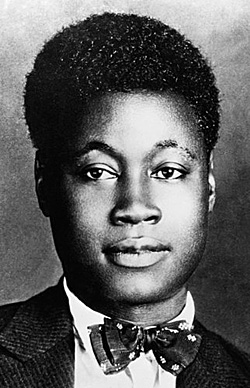 Claude McKay: Gay Sojourner in the Harlem Renaissance
Claude McKay: Gay Sojourner in the Harlem Renaissance
by Stephen O. Murray
February 28, 2011
I have long been interested in the Harlem Renaissance, an interest that was much expanded by a show at San Francisco’s Palace of the Legion of Honor about ten years ago.
Though I can understand why their elder (who also outlived almost all of them), W. E. B. DuBois sought positive portrayals of upstanding Negroes (to use the term then current), I can also understand the resistance of younger writers who wanted to “tell it like it is” among the underclass majority. Then as now, audiences reveled in sex and violence more than in uplifting tales of the upstanding. Then as now, uninhibited portrayals of uninhibited action and actors exaggerated pathology in the name of “naturalism” and arguably reinforced prejudices about “animalistic” lumpenproleterians. (“Lumpen” means below and “proletarian” means a worker for wages, working without owning the means of production.)
 In a review in the NAACP periodical Crisis that he edited, DuBois attacked Infants of the Spring, the 1932 roman à clef of the “Niggerati Manor” written by Wallace Thurman and the collection of work by the naturalistic avant-garde in Fire!!
In a review in the NAACP periodical Crisis that he edited, DuBois attacked Infants of the Spring, the 1932 roman à clef of the “Niggerati Manor” written by Wallace Thurman and the collection of work by the naturalistic avant-garde in Fire!!
The first round of DuBois vs. those showing hedonistic, irresponsible Negroes, however, was directed at Home to Harlem, a semi-autobiographical 1928 novel by Jamaica-born poet Claude McKay (1889–1948), who was not resident in the Western hemisphere during the heyday of the Harlem Renaissance. (He was in Europe or North Africa all but one year between 1919 and 1934.)
DuBois attacked the licentiousness in the book as “filth” and as encouraging the smart set (during Prohibition when Harlem was in vogue) to project their licentiousness onto black Harlem (as in Carl Van Vechten’s Nigger Heaven). In DuBois’s view McKay had used “every art and emphasis to paint drunkenness, fighting, lascivious sexual promiscuity, and utter absence of restraint in as bright and bold colors as he can” and “appealing to the prurient demand on the part of white folk for a portrayal in Negroes of that utter licentiousness which conventional civilization holds white folks back from enjoying.”
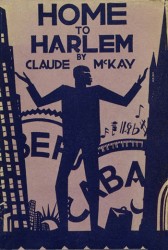
In a reply that has been well known at least since Wayne Cooper’s 1987 Claude McKay: Rebel Sojourner in the Harlem Renaissance, (Schocken Books), McKay shot back that DuBois’s role as an advocate for betterment of the race blinded him to what was going (in real life). McKay wrote that he was not surprised that DuBois mistook “the art of life for nonsense and try to pass propaganda as life in art” and signed the letter “Yours for more utter absence of restraint.”
McKay’s second published novel, Banjo: A Story Without a Plot (1931), showed a black diaspora set of dockworkers and layabouts (including those laid for pay) in Marseilles. “It was if every country of the world where Negroes lived had sent representatives drifting into Marseilles,” McKay wrote. (The Marseilles slum called the Ditch seems empty of anyone born in France.)
Despite the title, Banjo, the nickname of Alabama-born Lincoln Agrippa Daly, it is a version of the author from the Caribbean (Haiti rather than Jamaica) via Harlem—as in Home to Harlem named “Ray” (rhymes with McKay)—who is the main character. Ray is a sometimes poet too intellectual to relax and enjoy whatever may come as Banjo and others of “the boys” do. Also, Banjo has heterosexual relations; Ray has none in the book, though (like McKay who never saw the son his wife bore) Ray had left a progeny and its mother back in the USA. At the end of the novel, they go off together.
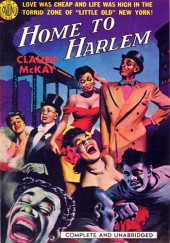
In his jargon-heavy Claude McKay, Code Name Sasha: Queer Black Marxism and the Harlem Renaissance (University Press of Florida, 2007) Gary Edward Holcomb interprets Ray’s question about Banjo’s sometimes mistress as indicating wanting to take her along, whereas I interpret it as making sure Banjo didn’t want to taker her along.
I think that Holcomb’s book very badly needed editing, not only to reduce the tsunami of jargon but also to reduce repetitions. One phrase that he repeats many, many times is that Home to Harlem, Banjo, and the unpublished novella Romance in Marseilles were “queer black Marxist anarchist bombs.” He also repeatedly calls them “manifestoes,” despite their lack of coherence (political in the traditional sense, or in sexual politics; they are laissez-faire in the latter).
Though Holcomb provided an extended account of DuBois’s attack on Home to Harlem, he ignored McKay’s counter blast about propaganda and insistence on showing “life.” There is certainly discussion among the characters and in representing Ray’s thinking of race and class in the African diaspora. Moreover, McKay had been a communist, addressing the Comintern in Moscow in 1922, had his book on lynching of Negroes in the U.S. published by the Soviet state in 1925, etc. However, McKay was in on the losing side of the struggle for power following Lenin’s death in 1924, that of Trotsky, rather than the winning one, Stalin’s.
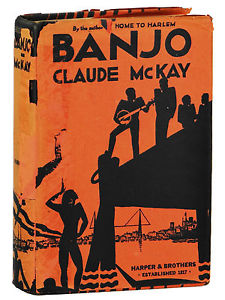
Moreover, from the time of Marx and Bakunin, certainly through the Bolshevik consolidation of power and elimination of other leftist factions and parties (very much continued during the failed defense of the Spanish Republic), communists sought to eliminate anarchists and anarchist ideas. That is, “communist anarchist” is an oxymoron, and “Queer resistance authorizes the act of uncovering the intimate relationship between sex radicalism, race resistance and leftist anarchism, as the queer… must inhale and exhale anarchy, or permanent revolution” is incoherent (“permanent revolution” being a code word for the Trotskyite position that has a technical sense that Holcomb ignores to link it to “sexual revolution”).
This it not to deny that anarchist ideas appealed to McKay before and after his Leninist and Leninist-Trotkyite associations, but, as was McKay, Ray had been through and was beyond his phase of fealty to communism. Both were critics of faith in the workers (proletariat) as “the universal class” or the Leninist “dictatorship of the proletariat” that Trotsky did more than Stalin to establish across the Soviet Union.
In the first chapter, following a very dense and polemical introduction, Holcomb contends (without much showing) that McKay’s FBI file is a more accurate account of his communist involvements than McKay’s 1937 autobiography
A Long Way from Home in which McKay downplayed how committed he had been. Neither Holcomb nor anyone else to my knowledge has sought to examine archival material in Moscow that might settle the question of whether McKay was a paid agent of the Comintern in Marseilles (after he left the Soviet Union), as British intelligence also supposed.
It seems to me that the FBI surveillance mixed two “Sashas” together, though one was clearly McKay. McKay’s autobiography reduced the extent of his Comintern career as well as covering up his homosexual liaisons (not just his initial gay white Jamaican patron Walter Jekyll and Waldo Frank, but Edward Arlington Robinson, and Countée Cullen, DuBois’s gay son-in-law for a few months). Though I think that McKay was masculinist and contemptuous of “queers,” McKay (like Thurman and Cullen, both of whom also married women briefly) seems to have been predominantly homosexual in orientation. McKay was also sympathetic to sex workers, including a male one in Romance in Marseilles (another disparity between the “sex radical” trilogy and A Long Way from Home is condemning prostitutes rather than accepting and justifying them.)
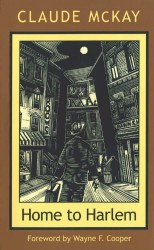
Having recently reread Banjo, I can see why it appealed to the future prophets of Négritude (Aimé Cesaire and Léopold Senghor) in its inclusivity of Africans (“Senegalese” was a cover term for those from sub-Saharan western Africa), U.S. blacks (Banjo), and Caribbean ones (Ray/McKay). Though DuBois again complained about the lack of a plot (a lack already stipulated in McKay’s subtitle), he approved of its linking of “Black Atlantic” peoples, and did not make an issue of the dissolute life ways, though they reinforced stereotypes of “shiftless Negroes,” inclined to crime, substance abuse, and sexual promiscuity.
Having also recently read James B. McKee’s Sociology and the Race Problem: The Failure of a Perspective (University of Illinois Press, 1993), I was attuned to the considerable extent to which McKay’s opposition of black behavior based on instinct in contrast to (white) civilization fit with the dominant U.S. discourse about child-like blacks in need of white tutelage before being ready to participate in democracy, and the related view that blacks were incapable of political agency, that is, of advancing the interests of the “race” without white leadership. (The 1955-56 Montgomery, Alabama bus boycott that thrust Martin Luther King, Jr. onto the national stage, rehearsed in the 2001 HBO documentary Boycott, was a shock to white liberals as well as to the southern white establishment.) It seems to me that Banjo reinforced both beliefs, even though he did not share the valuation of “black culture” as inferior and stunted. Ray/McKay, like D. H. Lawrence and Wyndham Lewis, viewed black folk as closer to “nature” and considered “primitive” being more “authentic” than “civilized.” A strong argument could be made (adumbrated by DuBois’s attack) that far from being “counter-hegemonic,” McKay’s characters are “minstrely” and reinforce ideas of inferiority (rather than of creativity and resistance) and inability to organize and engage in political action.
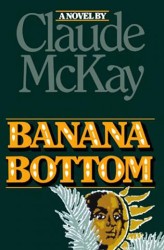
While Banjo endorsed racial solidarity across national boundaries, there is much in it that was very comfortable to those seeking to justify those seeking to justify inferior status for Negroes and to regard communist organizing of Negroes to be using black dissatisfactions (the eventual conclusion reached by Richard Wright, Ralph Ellison, and seemingly by McKay himself in his autobiography that Holcomb regards as not merely untrustworthy but as designed to obfuscate).
I am not convinced that McKay was writing for black readers, though Holcomb claims that in writing Home to Harlem, Banjo, and Romance in Marseilles, McKay “was an agent provocateur, inciting back proletarian agency, through his novels written for black readers in the United States.” It should be obvious that McKay was unaware of what Antonio Gramsci was writing in his Prison Notebooks (hint: these were not published until after McKay’s and Gramsci’s deaths), though there may be some leftist zeitgeist of focusing on culture as a site of struggle (despite hegemony) rather than culture being an epiphenomenon (superstructure to the base in the economy).
McKay was enthusiastic about revolutions, though not convinced that justice (racial or any other kind) would result from them, but if he had not been a black sympathetic to the early Bolsheviks (yes, I mean potentially useful), I suspect that his views would have been dismissed as “infantile leftism” by Lenin, and certainly after the Stalinist orthodoxy rejected “permanent revolution” (for the development of “socialism in one country,” i.e., the USSR). McKay inspired black nationalists, not subordinating struggle against racial injustices to class struggle. (I won’t get into the disparity between Stalin’s theory and practice about national(ist) minorities here or try to adjudicate the true motives of American communist Negro organizing.)
Holcomb makes a lot of assumptions without any documentation about what McKay was familiar with, including the “Scottsboro boys” case back in the U.S.A., or whether McKay was as fixated on Hemingway’s The Sun Also Rises and Eliot’s The Waste Land as Holcomb is (yes, they are canonical modernist works for us, but were they for McKay during the early 1930s?)… and that the “real McKay” was not the one writing of a Caribbean female protagonist in his third published novel, Banana Boat, but the diasporic black males(with more explicitly homosexual ones) in the unpublished Romance in Marseilles.
I very much doubt that McKay would have accepted the identity label “queer,” though the now-current rejection of identity/ies might have appealed to him. I also question whether the blond(masculine)/blonde (feminine) distinction was salient for McKay. In my experience there are many native speakers of English who do not make the distinction in writing, though I am well aware that McKay was writing Romance in Marseilles in the French “protectorate” of Morocco. How thorough was his command of French is not something addressed in the secondary literature, alas.
Similarly, I question Holcomb’s interpretations of the gender of Big Blonde and Petit Frère on the basis of those nicknames (the masculine gender of the word “frère” is obligatory in French, as is that of “pain”). I am far from convinced that the little one is a metonym of the phallus (eaten rather than eating), though McKay did not include any scenes of sex acts that would have specified who was doing what to whom. (McKay’s alter ego, this time named St. Dominique, is again celibate throughout the novel, and nonjudgmental (laissez-faire) rather than being in any sense a “sex radical” openly endorsing homosexual relations in print or even in manuscript.)
Conclusion
Holcomb rejects the cogency of “Old Left,” though the cultural politics in McKay seems to fit better with the “New Left” rejection of “vulgar Marxism” than with Communist perspectives from the 1930s. McKay’s use of dialect and lack of ability to structure his fiction (plot is not the only possibility, and coherence is not the only value) make for difficult reading. Like McKay, Holcomb throws out a lot of ideas. Though I was stimulated by Holcomb’s book—not least stimulated by questioning his certainties about what McKay felt and meant and by the incoherence of supposed manifestoes from an author who so violently rejected the propagandizing mission of DuBois—I think it is unreadable to those not versed in the wide range of theories from which he, like a magpie, picks shiny pieces. Holcomb parades bits from Bhabha, Butler, Derrida, Deleuze and Guattari, Fanon, and Foucault that often seem tangential displays of having read Theorists rather than aiding his analysis of what McKay was up to, which, to myself borrow a formula from Foucault, was bodies and pleasures, not theories about the intersection of race, class, and homosexuality that Holcomb wants them to have been about.
Holcomb has a thesis (that McKay was much more committed a leftist into and through much of the 1930s than those who accept his autobiographical account suppose) that has considerable merit and strength, but that the picaresque fiction about hedonistic blacks with lengthy folk philosophizing form a manifesto (together or separately) I find difficult to credit.
[2017 P.S. The novel McKay wrote in the Maine woods (the only one he wrote on US soil) that was recently published, Amiable with Big Teeth is very, very negative about the Stalinist working in Harlem and preoccupied with labeling Trotsky a “fascist” and trying to enforce Stalinist orthodoxy on blacks sympathetic to Ethiopia invaded by fascist Italy.]©2011, 2016, Stephen O. Murray
This first appeared on epinions 28 February 2011


